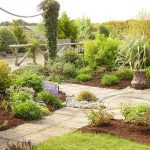Gardening with Anne McKeon
The colour blue is in my opinion, a very classy colour adding a sharpness to any garden setting. It conjures up images on the one hand of Mediterranean holidays, azure skies and seas while on the other hand reflects the ‘moody blues’. It is in effect a very versatile colour. Mix with it minor shades of blue such as lavenders and mauves and you have a very calming setting, which is of course something that we all strive for in our ‘fast – lane’ lives.
It is a fact that shades of blue look even more definite when planted with other colours such a yellow and white. Planting them in a scheme with complimentary colours gives a ‘true blue’ look. Monet, the Impressionist artist tended to use yellow as a contrast to blue. In keeping with the art theme, I read somewhere that the Vincent Van Gogh said ‘There is no blue without yellow and orange. When you paint blue, paint yellow and orange as well’.
Blues in spring are cheerful and fresh. To achieve this ‘freshness’ consider planting Grape Hyacinths(Muscari armeniacum), Forget – me –nots (which incidentally are the first plants I ever learned about, at the tender age of 5 years) and Anemone blanda. Aplant with medical connotations is the lung wort (Pulmonaria angustifolia). This easy to grow perennial is a must in any garden scheme, with its intense blue colour and spreading habit.
As a summer treat, plant Geranium Johnsons Blue to mirror the blue summer skies. In a dry site plant cat mint (Nepeta Six Hills Giant). These make lovely individual plants but look particularly well if planted to form a very low hedge skirting a pathway. A must have is one or more of the Ceanothus types. I have a particular fondness for the dwarf formCeanothus Yankee Point and for the taller Ceanothus Victoria. These will definitely benefit from a little shelter. Aquilegia Hensol Harebell (often known as columbine or grannies bonnet) are spectacular and worthy of inclusion in your herbaceous border. Be warned though, they tend to seed themselves everywhere but I am inclined to regard this as a plus rather than as a minus.
Soft blues rather than stronger shades suit the summer season better. In order to achieve this softness, plant Campanula persicifolia or Campanula glomerata or any campanula for that matter. You really can not go wrong with this family of plants. If you have an acidic, woodland situation plant blue poppies (Meconopsis). They can be a little temperamental but well worth the effort.
Colours tend to deepen in the early autumn light. At this time of year plant the darker blues and purples such as Salvia King George and Aconitum carmichaelii. Blue Delphiniumsare stately and add dignity to any late summer and early autumn border. Be prepared however to wage war on the slugs if you plant delphiniums.
There are no set rules when selecting your colours. At the end of the day it boils down to personal choice. Be prepared to be adventurous and let trial and error be part of your plan until you discover what takes really your fancy.
Happy Gardening!
Anne.
Garden Checklist.
· Stake border perennials.
· Dead head roses.
· Spray rose bushes.
· Remove rose suckers.
· Continue trimming hedges.
Anne McKeon of Gum Dearg Teoranta,
Buaile Beag, Bearna, Galway operates a Garden Design & Advisory Service. Anne presents a gardening spot on Galway Bay FM radio every second Thursday morning at 10.50am approx. and writes gardening articles for various publications. To date Anne has also written two gardening books, one for adult beginner gardeners (Don’t Forget Your Shovel) and one for children (Green Acres – Hobby Gardening For Children).
Phone: – (091) 521186 (office)
087 1441623 (mobile)
e. Mail. [email protected]



